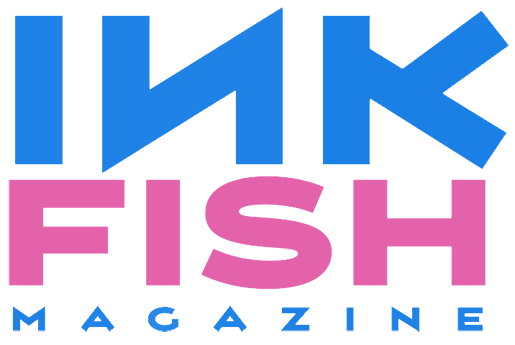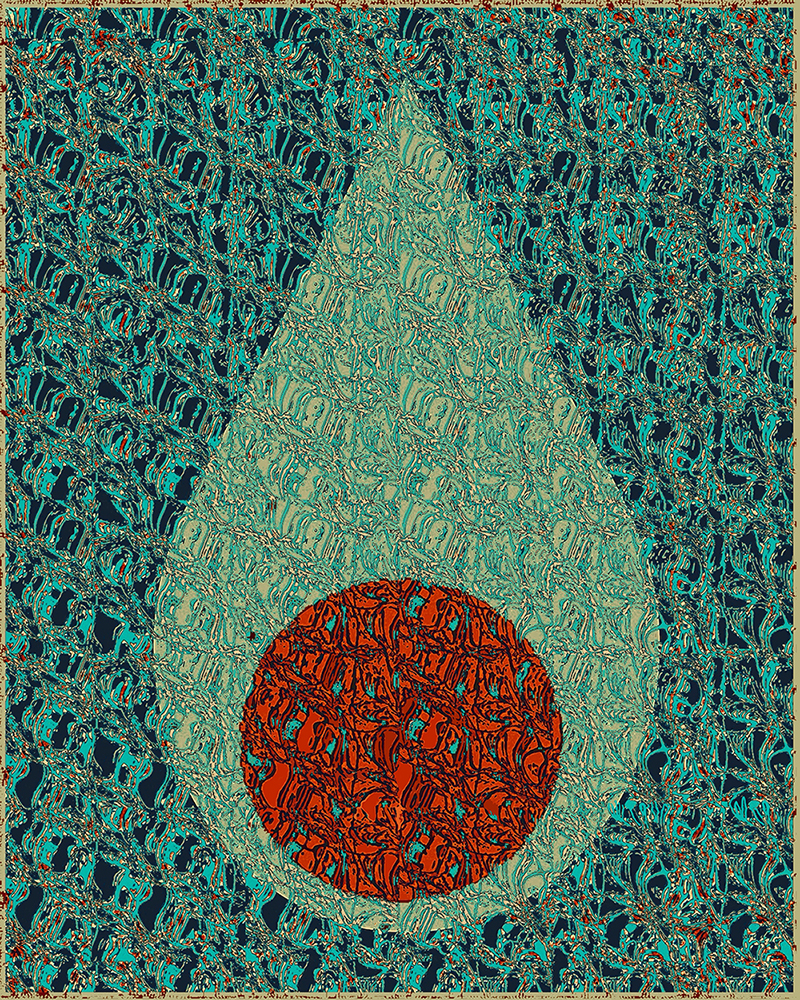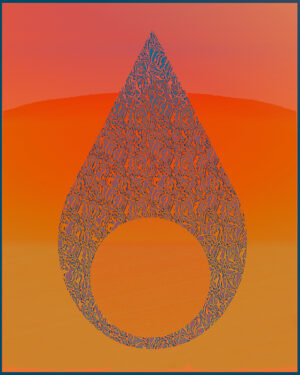Interview with Laura Kerr
Visual artist and poet
Questions by Kate Horsley
You are both a poet and a visual artist. Does one or the other of these feel primary to you, or are they both equal passions?
They are equal passions, but I feel a little more at home in the visual art world. Maybe because I have far more years of experience as an artist; my husband is an artist and most of my friends are artists. That said, it doesn’t seem strange to call myself a visual poet, either, because I often include text in my work.

Your art is incredibly distinctive. How did it evolve? And which artists and writers have influenced you the most?
Thank you for saying that! My art has evolved over many years, almost like a natural progression, mixed with determination to attempt to create something new. I formed an early art appreciation for process artists such as Lynda Benglis, performance artists such as Chris Burden, and the Fauvist Artists, with Henri Matisse being my foremost inspiration when it comes to the canvas. Many text artists like Christopher Wool, Jenny Holzer, and Barbara Kruger have definitely influenced my work as well. They really understood the power of words.
Can you tell us a bit about your process. What inspires you in the everyday? Are there particular creative problems you encounter, and how do you solve them?
I take lots of photographs of whatever strikes my eye. I think I qualify as a photography hoarder. This includes my collections of old photographs from the 19th century. Daily, I read in small increments of time, write down ideas, draw, and paint my ideas that come to me. The last couple of years canvas painting has become a part of my process instead of a finished project. I paint to create something else. Eventually I photograph it in bits and pieces to be digitally edited into that something else. My only problem is lack of time, and lack of computational skills. There’s always something new to learn.
What is your favourite piece/series of your own work and what is the most experimental piece/series you’ve ever done?
My favourite series was a site-specific series of paintings, exploring a theme that runs through much of my work, which is opulence. It’s a loud theme sometimes, as my series of large-scale paintings exploring Grimm’s ‘The Fisherman And His Wife’ shows. The canvases were painted with rhinestones, beads, sequins, lace, etc., and took a few years to complete; it was technically a process art. I wanted to make them too beautiful, too decadent, too much, and yet alluring. And like the story, each painting – with the first one being just traditional paint – became more ornate and embellished. My most experimental work might be the visual poetry book published by NoPress called Monospaced Poems. I plan to make a pdf of it soon.
Click for a larger image.
It seems as if vispo walks a tightrope between what words mean and their visual impact. How do you feel the collision of these two art forms alters a reader/viewer’s understanding of both?
Yes, it’s a tightrope for sure. I know I have taken great liberties with the genre, experimenting with how far I can go. I often remove words I don’t think are needed. I’m like an editing machine, where it all ends up on the floor. I trust my readers. Many will understand what I am saying and even bring their own unique perspective to it. Most visual poets aren’t looking for word meaning, because it’s a visual language and experiencing it is very different from text poetry. If we use actual text, it often isn’t necessarily about the word(s), but rather about the word’s relationship with the image and/or the reverse. Mind you, we don’t just make visual poems for each other. Someone who is not a visual poet or poet once said they liked my book without ‘understanding what it means’. That’s a great compliment really.
I’ve read that your work merges digital technology with traditional mediums like painting, drawing and photography to create a new language of expression. How do you combine and balance those elements?
I think I may have touched upon that in question 3 but I will say a bit more about technology. I don’t have any formal training in tech but it has always played a part in my artwork dating back to my first desktop computer in the mid 80’s. I used to draw with the original (black & white) photoshop and then print it, apply colours to it with dry medium, then use the images to inspire a large-scale oil painting. Nobody saw the process, the only thing left was the canvas painting. The first one I called ‘Apple Blossom 1’ because I used a Mac.
Sometimes my creative process is similar to erasure poetry in that I am removing details by computer so that my work better emphasizes what I want to communicate.
In your work, what are the main borderlines between and intersections of traditional textual poetry, concrete poetry, visual poetry, and visual art?
I have an appreciation for many genres of visual art. The limitlessness of art. When I work with text poetry, it’s not unlike art to me, but obviously it hails from its own history. Perhaps I overstep some of the literary boundaries, but that spurs me on. The endless possibilities are the part of the process that I find exciting. I experiment with the relationships between typographical and spatial elements to present new language and meaning.
Click for a larger image.
Do you constantly keep pushing the boundaries of art/technology experiments or do you feel that you’ve now found your ideal language for expression in your current work?
No. I will never stop trying to develop a new language of expression. My art has always been connected to technology, and both art and technology are always changing.
You teach art – what do you love about teaching art? Do you ever discover something new when you’re teaching?
Teaching art has been a very positive influence on my artwork in so many ways. Primarily, it kept me from becoming too hyper-focused on my own work. You gotta look up. And the students offer a unique challenge in that I couldn’t just teach art from my own perspective – I had to teach visual art from the art world’s perspective. Of course they asked ‘what do you think?’ and I shared my own ideas but they, too, shared their own ideas. It’s a win-win situation to be a teacher. Very rewarding.
What are you working on at the moment?
I enjoy working on several projects at a time. I am working on a commissioned canvas painting, a music album cover design, a visual poetry book, publishing an online visual poetry pdf journal called InterPoem, and my newest venture in the very near future is a podcast.
Finally, what advice could you offer to writers and artists who want to experiment with hybrid forms and intermedia?
There’s a huge amount of free information on the internet. There are a number of artists/poets who are willing to chat about their work and give advice. Look at what’s currently being done. And above all else believe in your work and craft your own path.
About Laura Kerr
Laura Kerr is an award-winning Canadian visual artist and poet. In 2012, she was honoured with a Queen Elizabeth II Diamond Jubilee Medal for her art & continued contributions to art education. She is co-owner of Paradise art, an art school in Winnipeg, Manitoba specializing in classical and contemporary art education where she has taught both youth and adults for over 25 years. Find Laura on Twitter.
About Kate Horsley
Kate’s first novel, The Monster’s Wife, was shortlisted for the Scottish First Book of the Year Award. Her second novel, The American Girl, was published by William Morrow (US) and Harper Collins (UK) and translated into Korean by Tomato Publishing. She loves experimenting with the shape of flash fiction and poetry and is working on her first short fiction collection and putting the finishing touches on her next novel. All her longer fiction has been optioned for film and television. Kate studied English Literature at Oxford and holds a PhD from Harvard. She has taught at Chester and Lancaster Universities and is currently a creative writing lecturer for Comma Press and the University of Hull.







